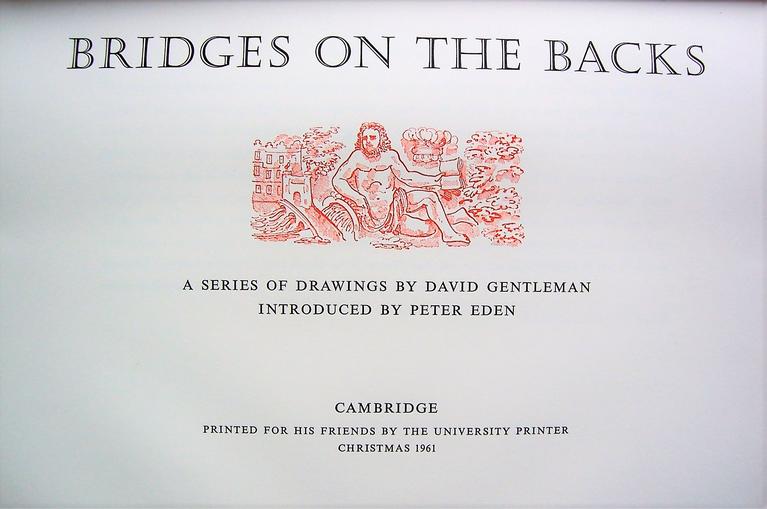Blog
15 December 2021

At Christmas in 1961, the University Printer, Brooke Crutchley, commissioned a small book of Bridges on the Backs in a very limited edition to send as a special Christmas gift to his friends. Sixty years later, this seems the season to share with Emmanuel members the copy in the Graham Watson Collection. For the illustrations Crutchley commissioned the young artist David Gentleman (b. 1930).
The book’s design is a homage to the use of illustrations on ‘before’ and ‘after’ paper lift-up flaps by which Humphry Repton – the fashionable garden designer of the Regency period – presented his clients with the contrast between present and future: their dull present garden and the transformed landscape that he undertook to provide. Except that in this little book about Cambridge bridges the movable flaps enable a journey from present to past: each flap turns back to reveal a sketch of an earlier bridge on the site.
So, on the page devoted to the Silver Street bridge, the top flap shows the present bridge, which had only recently been built in 1959, after designs by Sir Edwin Lutyens (d. 1944). Sharp-eyed readers will make out the wavy top edge of the flap as it runs through the trees on the left and over the Anchor Pub. But turn back this first flap to discover a second flap, and sketches of two earlier bridges on this spot.
.jpg)
.jpg)
The second flap shows a cast-iron bridge built in 1841, and underneath that an earlier wooden bridge.
.jpg)
.jpg)
For the page on King’s, the flap is illustrated with the present stone bridge, built in 1819 and designed by William Wilkins, who also designed the screen and entrance on King’s Parade. But when the flap is turned back, it shows a forgotten (and perhaps unregretted) earlier bridge, which was much nearer to Clare Bridge and aligned on the large Classical building next to the Chapel, the Gibbs Building.
.jpg)
.jpg)
The page devoted to Clare Bridge needs no flap since that most beautiful bridge of 1639-40 is the only bridge that has stood on that spot and is now by some way the oldest bridge on the Backs.
.jpg)
By contrast, the top flap for the Garret Hostel Bridge shows the brand-new crossing (just built in 1960). This flap turns back to reveal a second flap depicting the previous Tudoresque bridge, built in cast iron in 1835-7, and underneath this flap is a sketch of the wooden bridge that came before the cast iron one.
.jpg)
.jpg)
.jpg)
At St John’s, Henry Hutchinson’s scheme for New Court (1827-31) on the west side of the Cam required the building of the Bridge of Sighs in a Romantic Perpendicular style. When the flap depicting the Bridge of Sighs is turned back, it reveals that no bridge was needed here before.
.jpg)
.jpg)
Historically, the bridge by Magdalene was always the town’s principal river crossing – this was the ‘bridge’ in Cambridge. In the sketch the flap depicts the present cast iron bridge, built in 1823 and painstakingly restored in recent years (with consequent traffic chaos). Turn back the flap and see one of the many earlier bridges that have stood on this site.
.jpg)
.jpg)
Here was the working river, and below Magdalene Bridge were formerly quays and warehousing for the Cam as a trade and traffic artery: 1824 saw inauguration of a new steamboat service from here to King’s Lynn. Whereas the Backs have changed relatively little, this sketch of 1961 shows the now-demolished chimney of the power station that used to stand on this stretch of river opposite Magdalene.
In its homage to the beauties of Cambridge and of the colour-plate book tradition – albeit in a contemporary style – this unique Christmas gift book is an apt subject for our last blog of the year. We wish all our readers a very Merry Christmas and a Happy New Year.
Barry Windeatt (Keeper of Rare Books)
Images by Helen Carron (College Librarian)
